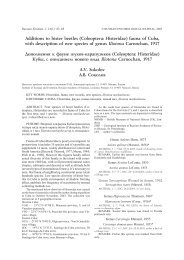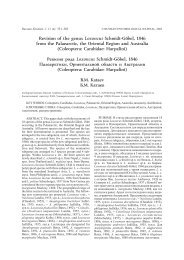A new genus and species of giant achilid from Madagascar
A new genus and species of giant achilid from Madagascar
A new genus and species of giant achilid from Madagascar
You also want an ePaper? Increase the reach of your titles
YUMPU automatically turns print PDFs into web optimized ePapers that Google loves.
Russian Entomol. J. 15(3): 259–261© RUSSIAN ENTOMOLOGICAL JOURNAL, 2006A <strong>new</strong> <strong>genus</strong> <strong>and</strong> <strong>species</strong> <strong>of</strong> <strong>giant</strong> <strong>achilid</strong> <strong>from</strong> <strong>Madagascar</strong>(Hemiptera: Fulgoromorpha)Íîâûé ðîä è âèä ãèãàíòñêîé àõèëèäû ñ Ìàäàãàñêàðà(Hemiptera: Fulgoromorpha)Thierry Bourgoin & Adeline Soulier-PerkinsÒ. Áóðãóýí, À. Ñóëüå-ÏåðêèíñMuséum national d’Histoire naturelle, Département Systématique & Evolution, USM 601 MNHN & UMR 5202 CNRS, 45 rueBuffon, F-75005, Paris, France. E-mail: bourgoin@mnhn.fr; soulier@mhnh.frНациональный музей естественной истории, отдел систематики и эволюции, USM 601 MNHN & UMR 5202 CNRS, ул.Бюффона 45, F-75005, Париж, Франция.KEY WORDS: Hemiptera, Fulgoromorpha, Achilidae, Emeljanocarinus gargantua, <strong>new</strong> <strong>genus</strong> <strong>and</strong> <strong>species</strong>,<strong>Madagascar</strong>.КЛЮЧЕВЫЕ СЛОВА: Hemiptera, Fulgoromorpha, Achilidae, Emeljanocarinus gargantua, новый род и вид,Мадагаскар.ABSTRACT. A <strong>new</strong> Achilidae (Hemiptera, Fulgoromorpha)— Emeljanocarinus gargantua gen. et sp.n.<strong>from</strong> <strong>Madagascar</strong> is described; it is probably the largest<strong>achilid</strong> ever described.РЕЗЮМЕ. Новый род и новый вид семействаAchilidae (Hemiptera, Fulgoromorpha) — Emeljanocarinusgargantua gen. et sp.n. описан с Мадагаскара;вероятно, это крупнейшая из известных ахилид.IntroductionWithin the Fulgoromorpha, <strong>achilid</strong>s appear to be avery distinguishable family not only because <strong>of</strong> someunusual morphological particularities (wings overlappingor male genitalia conformation for instance in most<strong>of</strong> them) but also because <strong>of</strong> several etho-ecologicalcharacteristics as their fungi diet during nymph stagesor their closer association with gymnosperms [Wilsonet al., 1994]. However these promising characteristicshas never attracted too much researches <strong>and</strong> this desaffectationis probably the result <strong>of</strong> a false uniformgeneral appearance <strong>of</strong> the different <strong>species</strong> <strong>of</strong> the family.Indeed, after the recognition <strong>of</strong> the family by Stål in1866, a major revision was only provided in 1950 byFennah. Fortunately, interest in <strong>achilid</strong> systematics <strong>and</strong>etho-ecology have come back in the recent years thanksto the works <strong>of</strong> O’Brien [1971] <strong>and</strong> more recently byAlex<strong>and</strong>er Emeljanov in various papers.In two <strong>of</strong> them [Emeljanov, 1991, 1992], the firstmadagascarian <strong>achilid</strong>s were described <strong>and</strong> grouped ina <strong>new</strong> tribe: Mycarini, within the supertribe Myconites.However, these two suprageneric taxa were proposedwithout autapomorphic characters [Emeljanov, 1992: fig.29] <strong>and</strong> were only isolated by elimination, as all othermajor taxa were characterized with at least one autapomorphy.Moreover Mycarini — restricted to <strong>Madagascar</strong>— were placed in a very basal position within the<strong>achilid</strong> phylogeny [Emeljanov, 1992]. Phylogenetically,Achilidae are always placed in a relative basal positionwithin the Fulgoromorpha [Bourgoin & al., 1997] <strong>and</strong>convincing fossils records appear in the Lower Cretaceous[Szwedo et al., 2005].Altogether, these observations suggest an interestinghypothesis <strong>of</strong> a vicariance event within the <strong>achilid</strong>s,some 120 millions years ago when <strong>Madagascar</strong> begunto separate <strong>from</strong> Africa. It also suggests some <strong>new</strong>investigations on the Asian material looking for theMycarini sister-group <strong>and</strong> the position <strong>of</strong> the VietnameseAmphignomini [the closer taxa according to Emeljanov,1992] within the <strong>achilid</strong> phylogeny. In order to testthese hypothesis <strong>and</strong> to take advantage <strong>of</strong> the importantundescribed madagascarian material preserved inParis Museum, a revision <strong>of</strong> <strong>achilid</strong> fauna <strong>of</strong> <strong>Madagascar</strong>has been undertaken [in prep.].As part <strong>of</strong> this work, we are very please to dedicateto Pr<strong>of</strong>. Alex<strong>and</strong>er Emeljanov at the occasion <strong>of</strong> his 70 thbirthday, the larger <strong>species</strong> <strong>of</strong> <strong>achilid</strong> ever described, inrecognition his major contributions in explorating <strong>and</strong>describing planthoppers biodiversity.Tribe MycariniMycarini Emeljanov, 1991: 382.[Emeljanov, 1992: 577; 1993: 10]Type <strong>genus</strong>: Mycarus Emeljanov, 1991.GENERA INCLUDED. Mycarus Emeljanov, 1991;Mycarinus Emeljanov, 1991; Acocarinus Emeljanov,1991; Emeljanocarinus gen.n.Three <strong>new</strong> monospecific genera were described byEmeljanov [1991] in the Mycarini: Mycarus, Mycarinus
A <strong>new</strong> <strong>genus</strong> <strong>and</strong> <strong>species</strong> <strong>of</strong> <strong>giant</strong> <strong>achilid</strong> <strong>from</strong> <strong>Madagascar</strong> (Hemiptera: Fulgoromorpha)261eyes, one yellowish spot between the 2 lateral carinae <strong>of</strong>pronotum on each dorsal side. Frons <strong>and</strong> clypeus brown,lines <strong>of</strong> maximal depth <strong>of</strong> intervals between carinae are dark<strong>and</strong> one yellow spot on each interval at level <strong>of</strong> epistomalsuture. Lateral parts <strong>of</strong> head, at level <strong>of</strong> metopa pale. Antennaebrown yellowish. The ridges on dorsal side <strong>of</strong> pronotumare yellowish pale. Mesonotum brown with yellowish spots,2 pale spots on anterior part <strong>and</strong> 2 pale spots on posteriorpart <strong>of</strong> disc <strong>of</strong> mesonotum, one dark spot on each side <strong>of</strong>mesonotum, out <strong>of</strong> disc <strong>and</strong> below posterior margin <strong>of</strong> pronotum.Fore wing (Fig. 2) clear brown with pale indistinct spots<strong>and</strong> reddish veins becoming paler near wing margin. Transverseapicals veins yellowish. M with M1+2 <strong>and</strong> M3+4bifurking at almost the same level, well before the subapicalline. C4 divided into a short basal cell (almost twice as long aswide) <strong>and</strong> a more elongated distal one by an additional transversevein at the level <strong>of</strong> the nodal line (first transverseCuA1–M before the nodal line). Pro- <strong>and</strong> mes<strong>of</strong>emur on thefirst three quarter dark brown, then a subapical wide yellowring. Pro- <strong>and</strong> mesotibia brown with a subbasal <strong>and</strong> a subapicaldarker rings. Metatibiotarsal formula: 1+(5–6)/7/7.Male unkown.Female genitalia. Medioventral process strongly developed,apically bifid, in ventral view lateral margins diverging<strong>and</strong> straight (Fig. 3). Gonapophysys apically produced in asmall sybquadrate process (Fig. 4).Total length. 14.5–15.0 mm.DISTRIBUTION. <strong>Madagascar</strong> Est: Antanambe.REMARKS. This <strong>species</strong> is very impressive — it isprobably the largest <strong>achilid</strong> ever described — <strong>and</strong> named afterthe <strong>giant</strong> Gargantua (name in apposition). The femaleparatype is partly damaged.ReferencesBourgoin Th., Steffen-Campbell J. D. & Campbell B. C. 1997.Molecular phylogeny <strong>of</strong> Fulgoromorpha (Insecta, Hemiptera,Archaeorrhyncha). The enigmatic Tettigometridae:evolutionary affiliations <strong>and</strong> historical biogeography //Cladistics. Vol.13. P.207–224.Emeljanov A.F. 1991. [Toward the problem <strong>of</strong> the limits <strong>and</strong>subdivisions <strong>of</strong> Achilidae (Homoptera, Cicadina)] //Entomol. Obozr. Vol.70. No.2. P.373–393. [In Russian.English translation published in Entomol. Rev. Vol.71.No.1. P.53–73].Emeljanov A.F. 1992. [Description <strong>of</strong> tribes <strong>of</strong> the subfamilyAchilinae (Homoptera, Achilidae) <strong>and</strong> reconsideration <strong>of</strong>their volume] // Entomol. Obozr. Vol.71. No.3. P.574–594. [In Russian. English translation published in Entomol.Rev. 1993. Vol.72. No.6. P.7–27].Fennah R.G. 1950. A generic revision <strong>of</strong> the Achilidae (Homoptera:Fulgoroidea) // Bull. Br. Mus. (nat. Hist.) Entomol.Vol.1. P.1–170.O’Brien L.B. 1971. The systematics <strong>of</strong> the tribe Plectoderini inAmerica North <strong>of</strong> Mexico (Insecta, Fulgoroidea, Achilidae)// Univ. Calif. Publ. Entomol. Vol.64. P.1–79.Swzedo J., Th. Bourgoin & F. Lefèbvre. 2004. Fossil Planthoppers(Hemiptera: Fulgoromorpha) <strong>of</strong> the world. An annotatedcatalogue with notes on Hemiptera classification. Warsaw:J. Swzedo. 199 pp + 8 pl.Stål C. 1866. Hemiptera Homoptera Latr. Vol.4. P.1–276.Wilson S.W., Mitter C., Denno R.F. & Wilson M.R. 1994.Evolutionary Patterns <strong>of</strong> Host plant Use by DelphacidPlanthoppers <strong>and</strong> Their Relatives // Planthoppers, theirEcology <strong>and</strong> Management. Eds. Denno & Perfect. Chapman& Hall. P.7–113.












